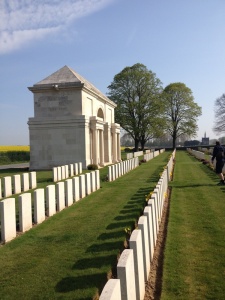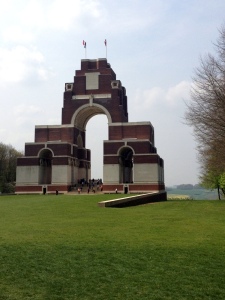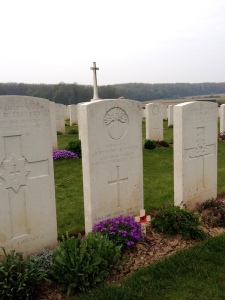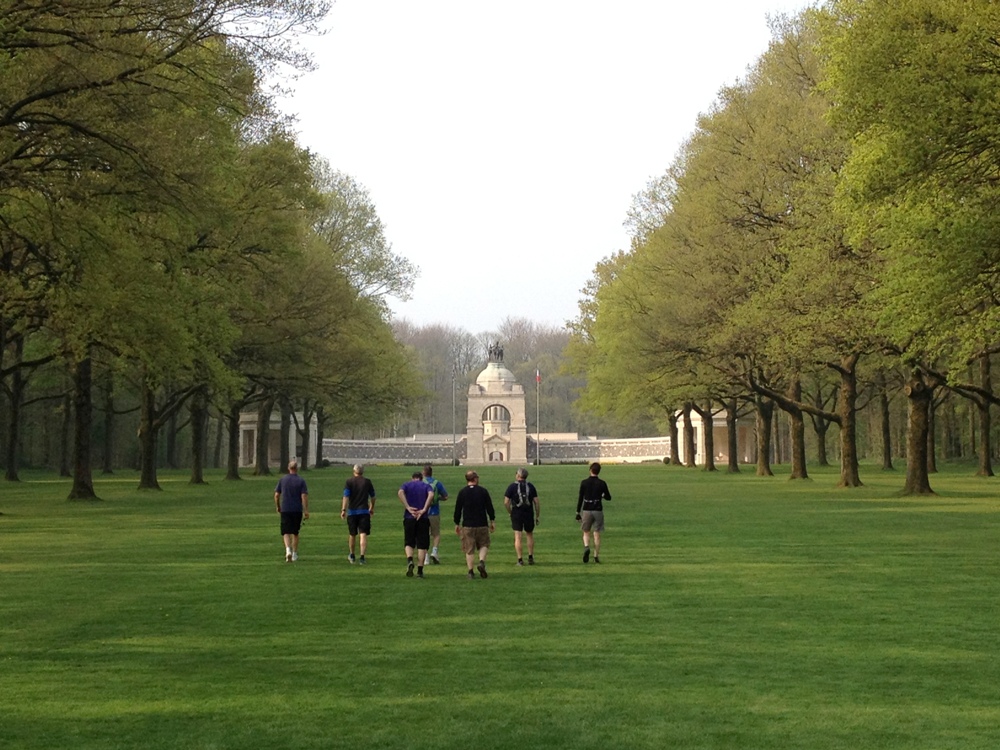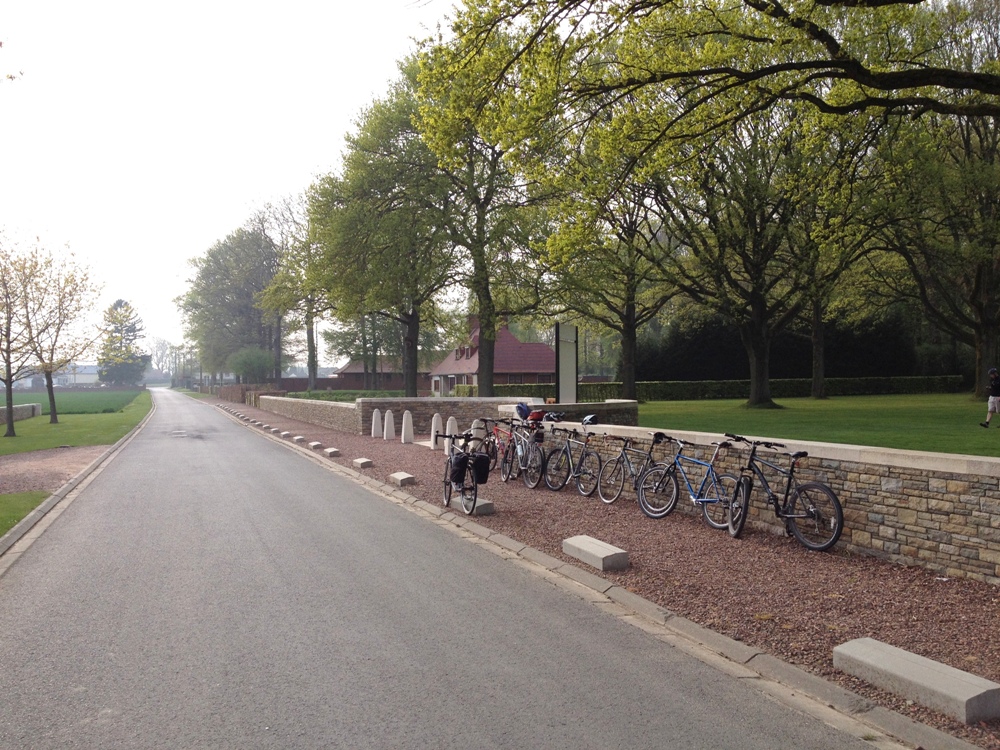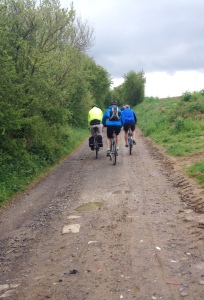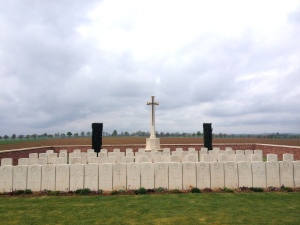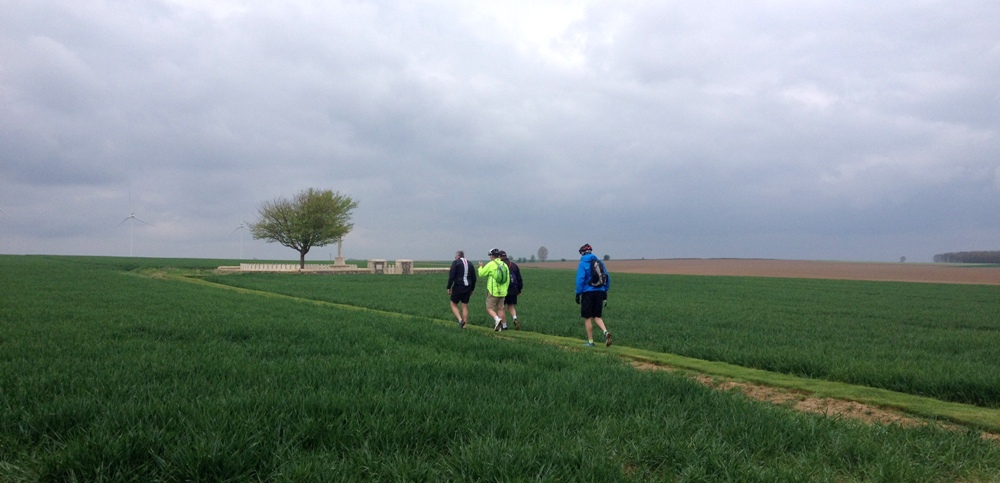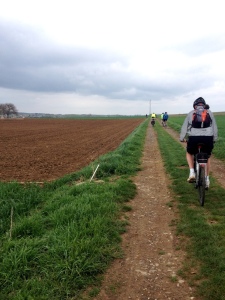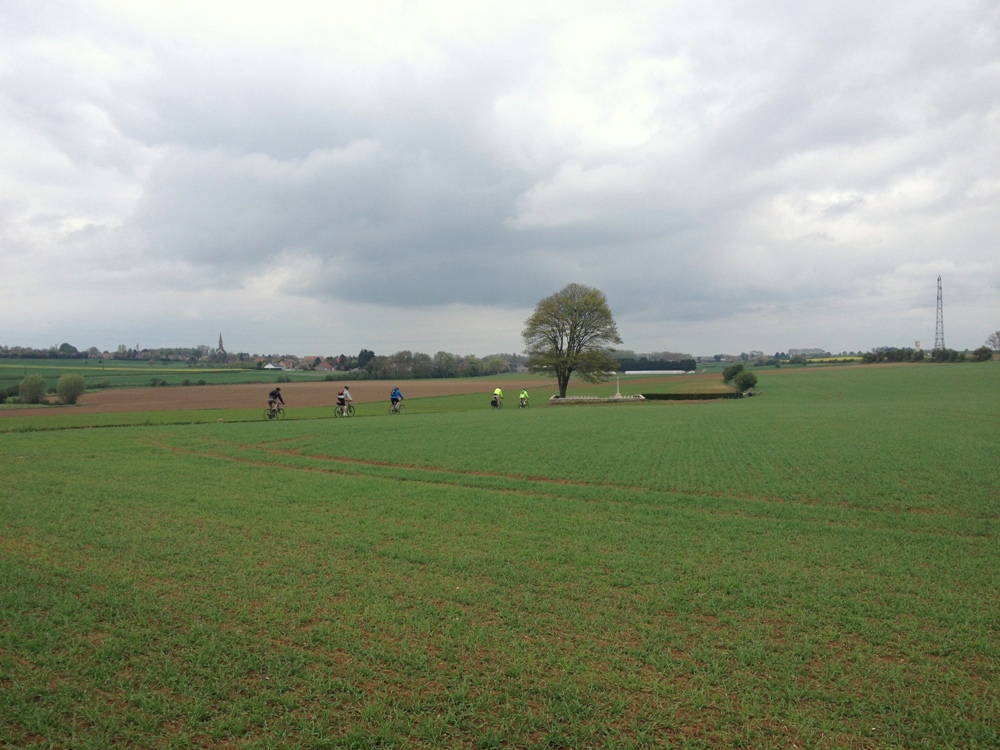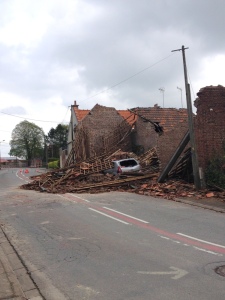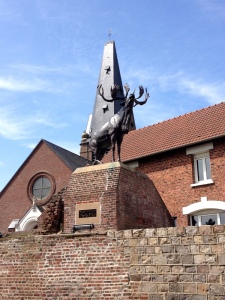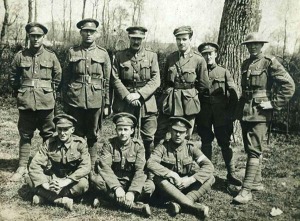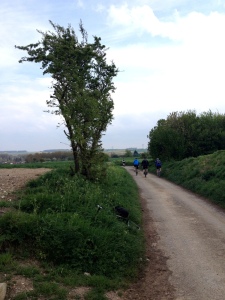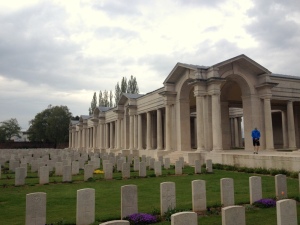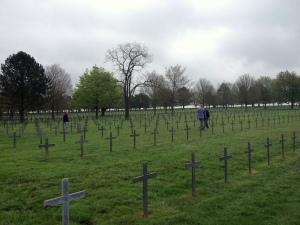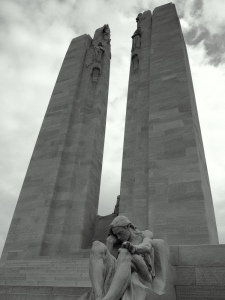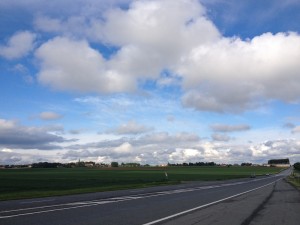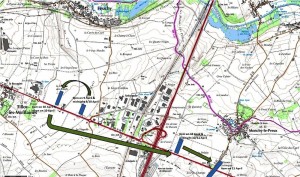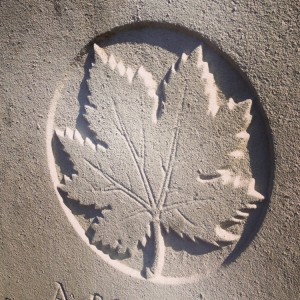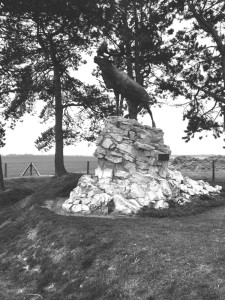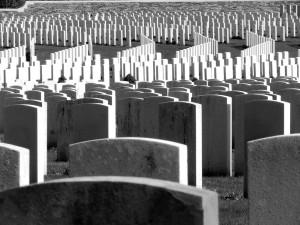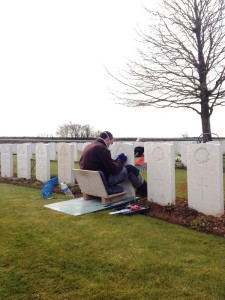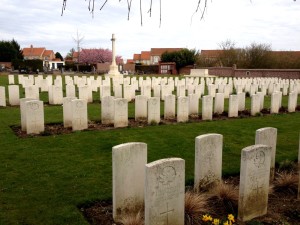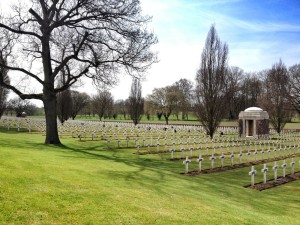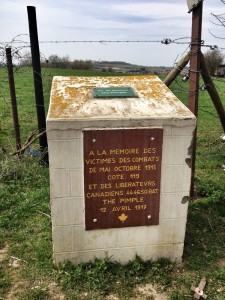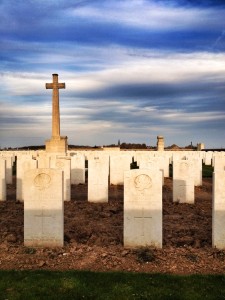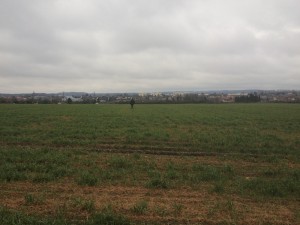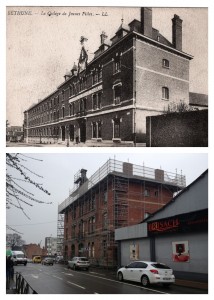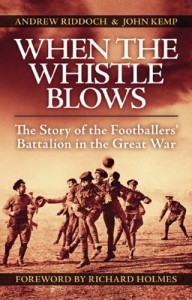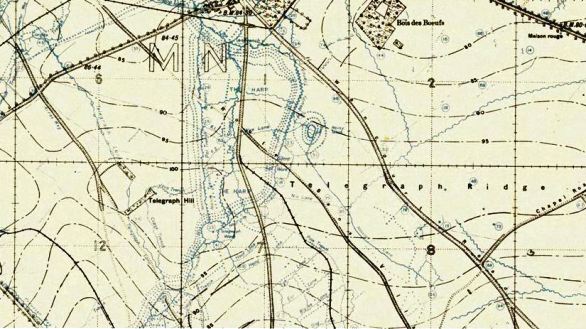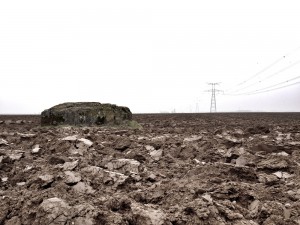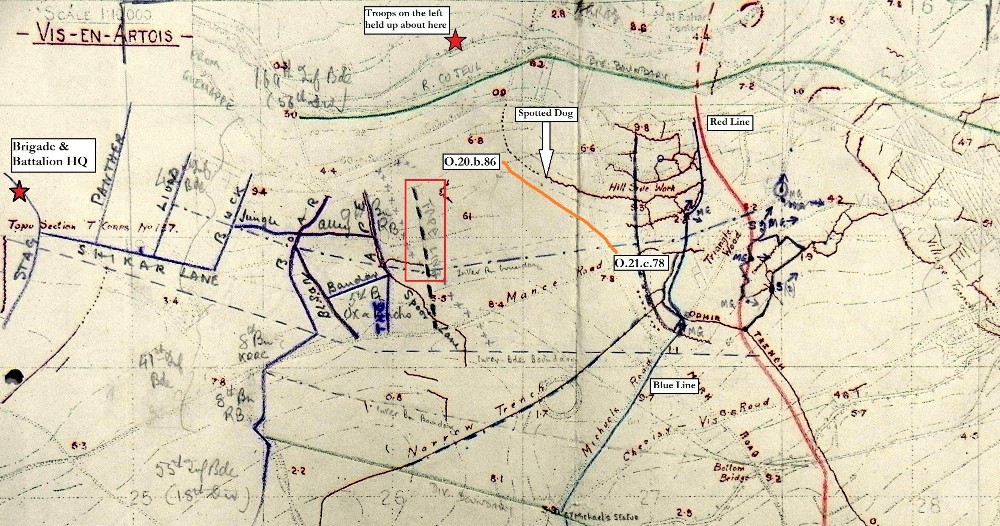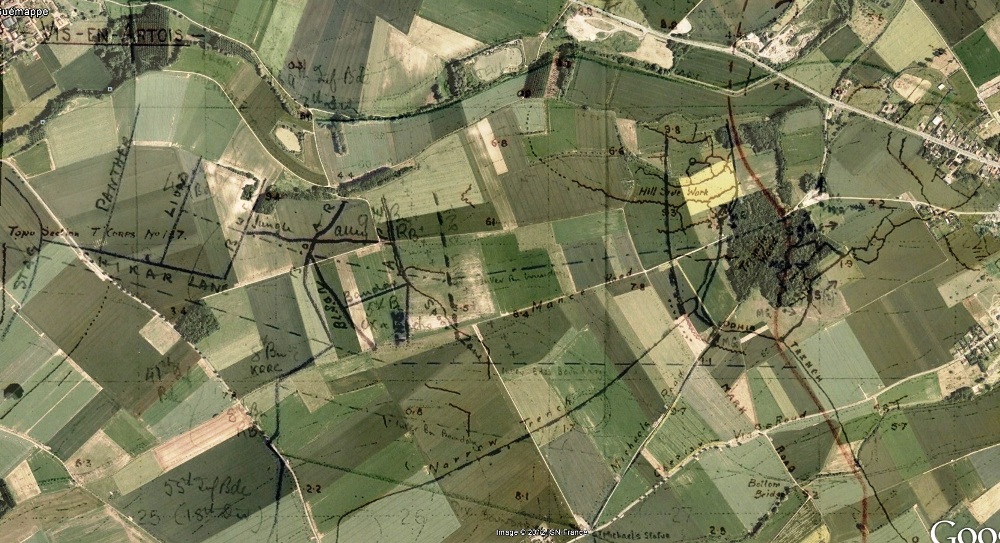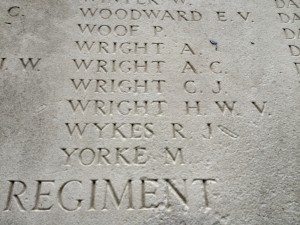Archive for the ‘Battlefield Tours’ Category
New Battlefield Tour announced! Western Front Footsteps: Stories of courage and endeavour above and below the battlefield and the postwar reconstruction of French communities, 24-27 September 2021
Following the success of the four years of Bristol and West Country based battlefield tours (2016-19) organised with fellow historian, Clive Burlton, we are pleased to announce another trip for autumn 2021. Our 2020 tour was cancelled due to the coronavirus pandemic, hence we are carrying over our suggested plans for that tour to 2021. Our focus is not solely actions by units from the West Country but on this tour will look at the role of the Tunnelling Companies and their incredible underground war, fought deep beneath No Man’s Land. We will also visit sites and tell stories associated with the post-war reconstruction of French communities.
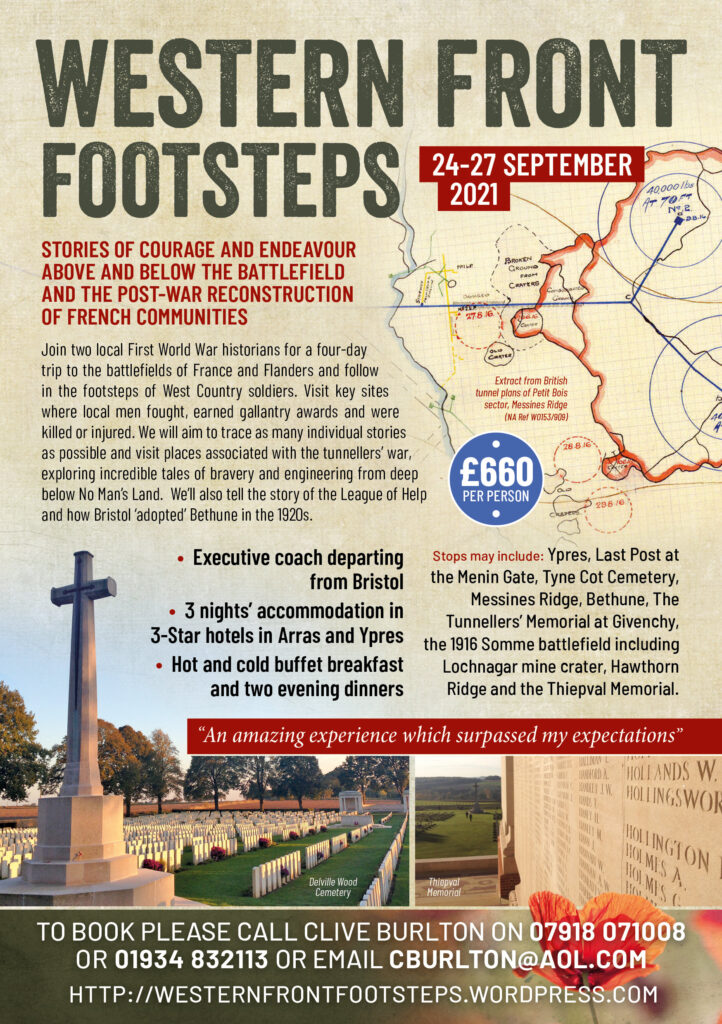
Once again we are travelling with our partners at Bakers Dolphin. The three night, four day tour will visit key sites associated with the West Country. Travelling by executive coach we will depart from Bristol on 24 September and travel to Arras, stopping at sites of interest en route.
The next day will be spent on the 1916 Somme battlefield with a look at the tunnelling exploits at such famous sites as Hawthorn Ridge, La Boisselle, Bois Francais and Carnoy. As ever we will ensure that we stop at key battlefield sites including the Thiepval Memorial.
On 26 September we will journey northward to the sacred Ypres salient and Messines Ridge, a key battleground for the tunnelling war. En route we will visit Bethune and the Tunnellers Memorial at Givenchy-les-la-Bassée for the tale of Sapper William Hackett VC, the only tunneller recipient of the Victoria Cross. Whilst in Ypres we will attend the Last Post ceremony at the Menin Gate. Other key sites around the salient will be explored.
As ever, our tour will cover the stories of relatives of those who join us. Please do send details and we will endeavour to visit individual graves and battlefield sites if time permits.
Accommodation is based at the following 3-star hotels – Holiday Inn Express (Arras) and the Novotel (Ypres). Full details of cost, what is included and contact details to reserve a space can be found on the attached flyer and via our dedicated website: https://westernfrontfootsteps.com/.
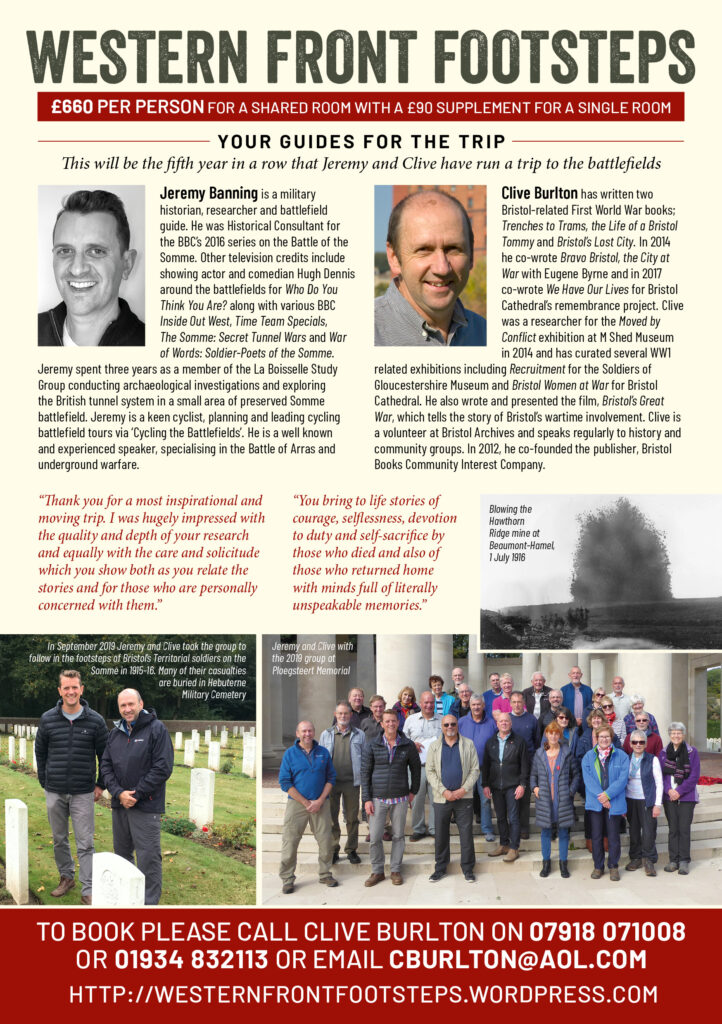
We look forward to you joining us for another wonderful few days following in some Western Front Footsteps…
Following the success of the last three years of Bristol and West Country based battlefield tours organised with fellow historian, Clive Burlton, we are pleased to announce another trip for this coming autumn. This time our focus is not solely actions by units from the West Country but a look at associated stories of the postwar period of battlefield tourism and creation of Commonwealth War Graves Commission cemeteries.

Once again we are travelling with our partners at Bakers Dolphin. The three night, four day tour will visit key sites associated with the West Country. Travelling by executive coach we will depart from Bristol on 27 September and travel to Arras, stopping at sites of interest en route. If time permits we will visit Fresnoy near Arras where the 12th Gloucesters (Bristol’s Own) fought with heavy losses in May 1917.
The next day will be spent on the 1916 Somme battlefield with a look at the Bristol Territorials at Hebuterne and a visit to key battlefield sites including the Thiepval Memorial. On our way down to the Somme we aim to stop at Mory Abbey Military Cemetery to hear a most moving story of a father’s love for his son.
On 29 September we will journey northward to the sacred Ypres salient , the wartime cauldron for so many of Britain’s soldiers. Whilst in Ypres we will attend the Last Post ceremony at the Menin Gate and walk in the footsteps of the 1st Somerset Light Infantry in December 1914 at Ploegsteert (known as Plugstreet to the Tommies). Other key sites around the salient will be explored. Throughout the trip we will be looking at the work of the war artists such as Nash, Levinson and Orpen.
As ever, our tour is based around the stories of relatives of those who join us. Please do send us details and we will endeavour to visit individual graves and battlefield sites.
Accommodation is based at the following 3-star hotels – Holiday Inn Express (Arras) and the Novotel (Ypres). Full details of cost, what is included and contact details to reserve a space can be found on the attached flyer.
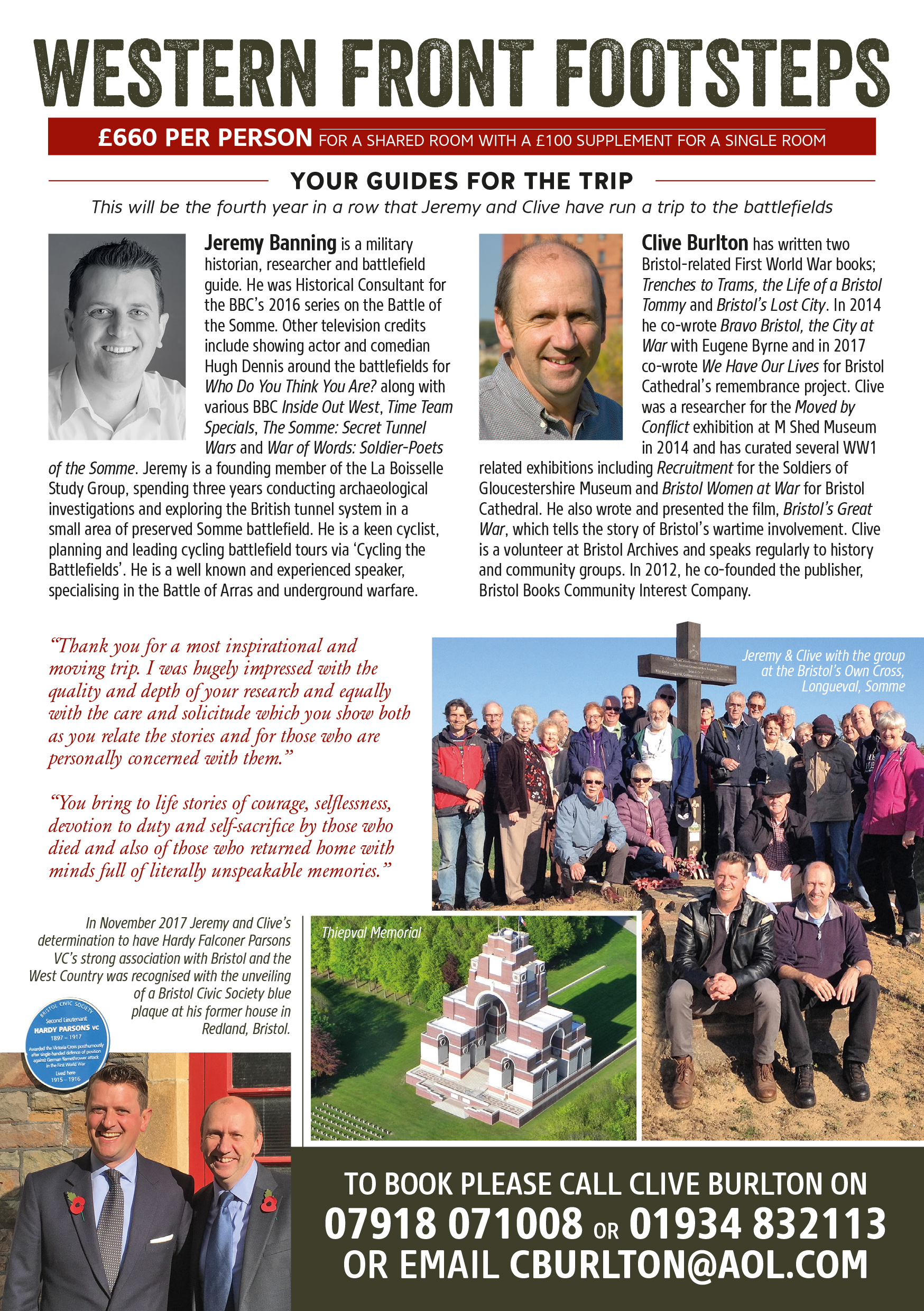
We look forward to you joining us for another wonderful few days following in some Western Front Footsteps…
Following the success of last year’s ‘Bristol on the Western Front’ trip that I organised with fellow historian, Clive Burlton, we are pleased to announce another trip for October 2017.
This year we are broadening the net with less of a Bristolian focus. Stops will cover actions by units from Wiltshire, Somerset and South Wales. As such, we thought it apt to name the tour ‘The West Country at War’.
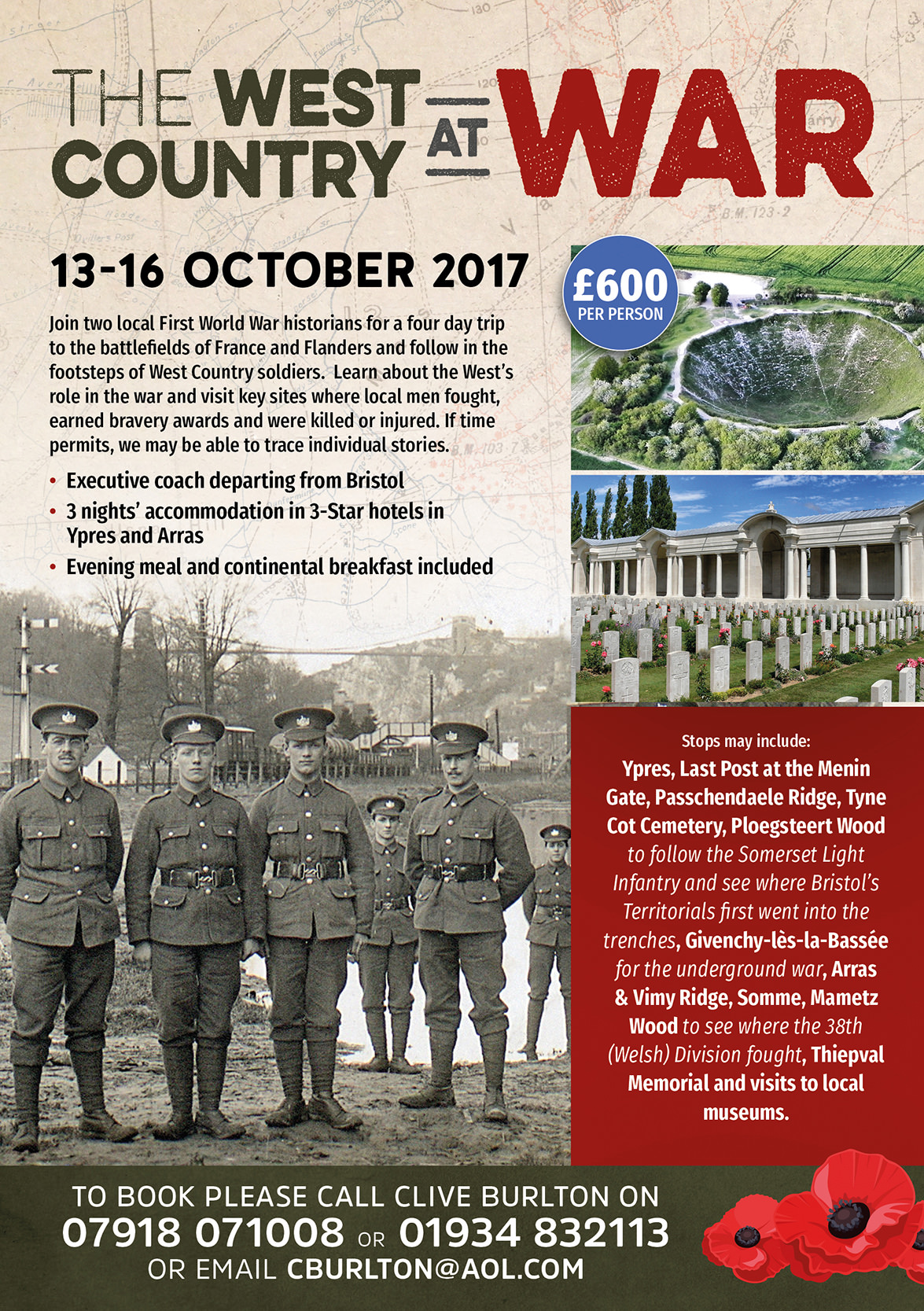
Once again we are travelling with our partners at Bakers Dolphin. The three night, four day tour will visit key sites where soldiers from the West Country fought, earned bravery awards and lost their lives.
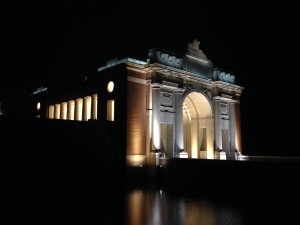
Menin Gate, Ypres
Travelling by executive coach we will depart from Bristol on 13 October and travel to Arras, stopping at sites of interest en route. The next day will be spent on the Somme battlefields, visiting some well known (Mametz Wood) as well as lesser known sites on the 1917 battlefield!
The following day sees us journey northward to the sacred Ypres salient , the wartime cauldron for so many of Britain’s soldiers. Whilst in Ypres we will attend the Last Post ceremony at the Menin Gate. Our time in Ypres will see us visiting sites around the salient including Ploegsteert (known as Plugstreet to the Tommies) to follow the 1st Somerset Light Infantry in December 1914, see where the Christmas Truce took place and visit the area in which Bristol’s Territorials first went into the trenches.
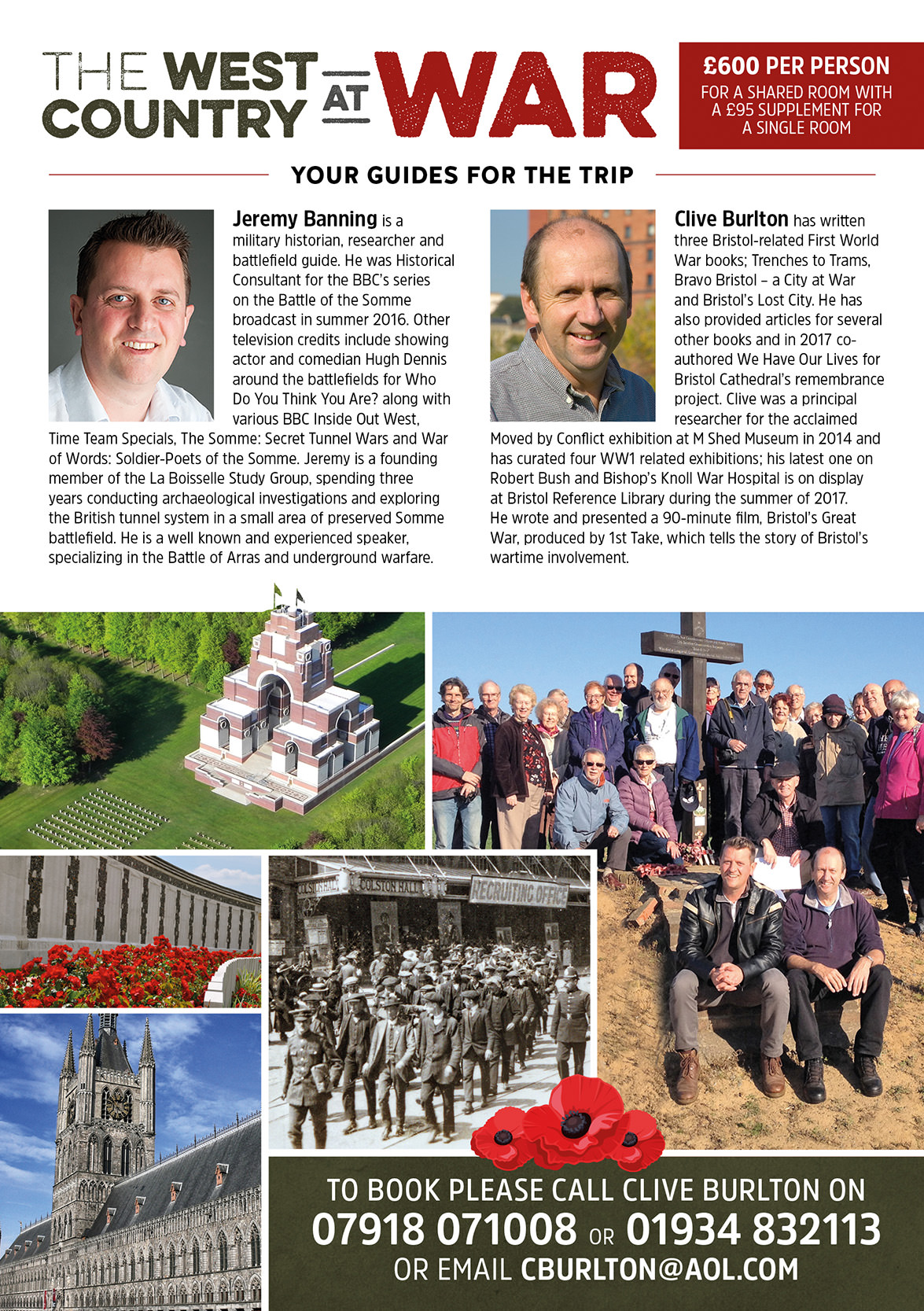
Accommodation is based at the following 3-star hotels – Holiday Inn Express (Arras) and the Novotel (Ypres). Evening meal and continental breakfast are included. If there is demand then Clive and I are happy to give evening talks. Last year we were heartened by the almost 100% attendance rate at our talks by those who had already had a long day on the battlefields.
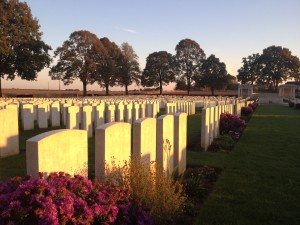
Delville Wood Cemetery, Somme
Full details of cost and contact details to reserve a space can be found on the attached flyer.
We look forward to you joining us for another wonderful few days!
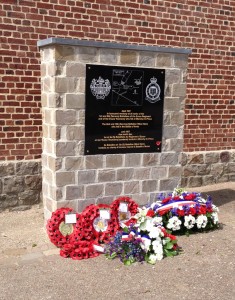
Memorial to commemorate the losses of the 1st Battalion Essex Regiment and the Essex Yeomanry at Monchy-le-Preux
Monchy-le-Preux has long been one of my favourite spots on the battlefields. The tale of its capture and subsequent defence make fascinating reading. As such, I was delighted to take my group of battlefield clients to attend the unveiling of a new memorial to the 1st Essex Regiment and Essex Yeomanry in the village square on Saturday 21 May 2016. The memorial is the brainchild of Dr Ted Bailey, whose grandfather served in the 1st Essex Regiment.
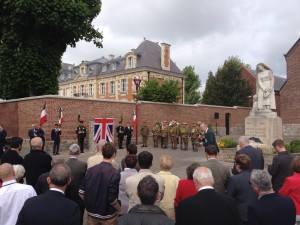
The start of the ceremony, 21 May 2016
Monchy was chosen as the site for this memorial as it is forever associated with the losses sustained by the cavalrymen of the Essex Yeomanry who aided the capture of the village on 11 April 1917. During this action, Lance Corporal Harold Mugford held back the advancing enemy singlehandedly, although seriously injured. For his actions he was awarded the Victoria Cross. Three days later the 1st Essex Regiment and Newfoundland Regiment launched an ill-fated push eastwards up Infantry Hill. The Newfoundlanders losses are commemorated with one of their five caribou in the centre of the village. Dr Ted Bailey has sought to redress this imbalance with a memorial to the memory of the Essex Regiment and Yeomanry.
The press release distributed prior to the unveiling provides additional detail on the two actions of the Essex Regiment and Yeomanry at Monchy:
On 11 April, the Essex Yeomanry, as part of a mounted division, bravely attacked Monchy in a snowstorm, galloping into the village but were met with heavy fire and lost 135 men, 29 killed in action, and most of their horses. Machine Gunner Lance-Corporal Harold Mugford doggedly defended the position under severe enemy pressure although severely wounded in both legs which were subsequently amputated. He was awarded the Victoria Cross and survived the war with distinction.
On 14 April, the 1st Battalion Essex Regiment attacked east of Monchy into a wooded area aiming for their objective, some high ground known as Infantry Hill. Initial success, with ground captured and prisoners taken, was reversed by a heavy German artillery barrage plus a simultaneous counter attack by the 3rd Bavarian Regiment, one of the enemy’s finest fighting units. The battalion suffered 661 casualties, so many that a temporary battalion had to be formed with the Newfoundland Battalion, named the ‘1st Newfoundessex’, comprising only 400 men.
Other Essex Battalions were also in the vicinity during this larger Arras engagement. The 2nd Battalion was in action on 9 April losing 78 men whilst the 9th Battalion lost 163 men.
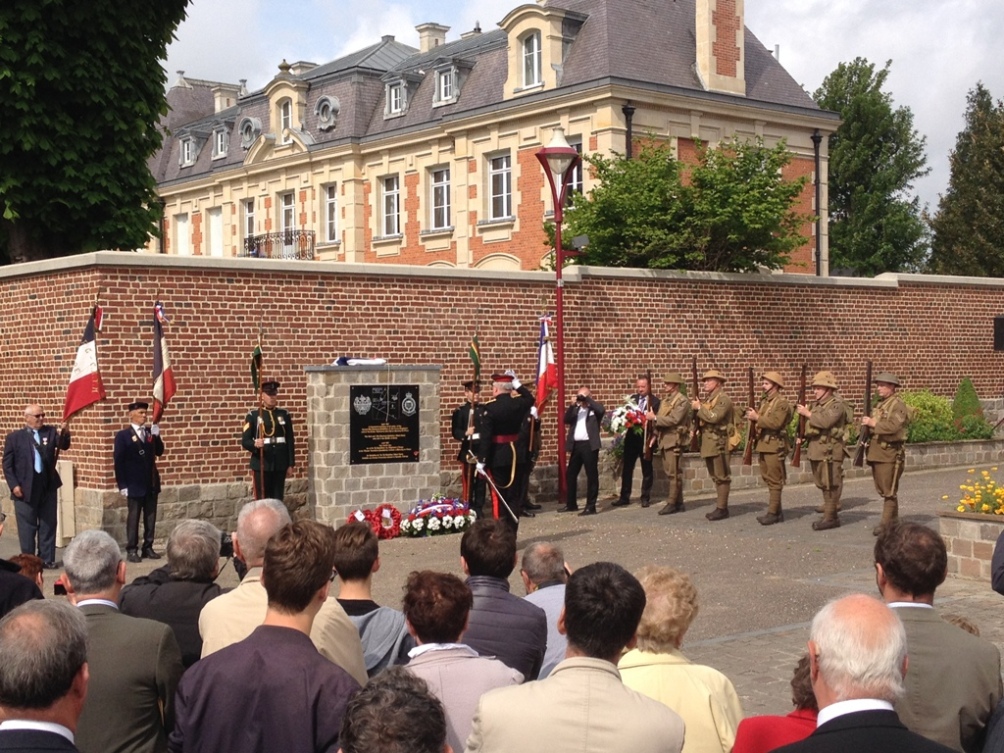
Wreath laying at the memorial
The unveiling ceremony was very well attended with a long list of dignitaries from the UK along with a great many locals. The memorial can be visited in the square outside the church just off the Rue de la Chaussy. It stands a mere 50 metres away from the Newfoundland caribou.
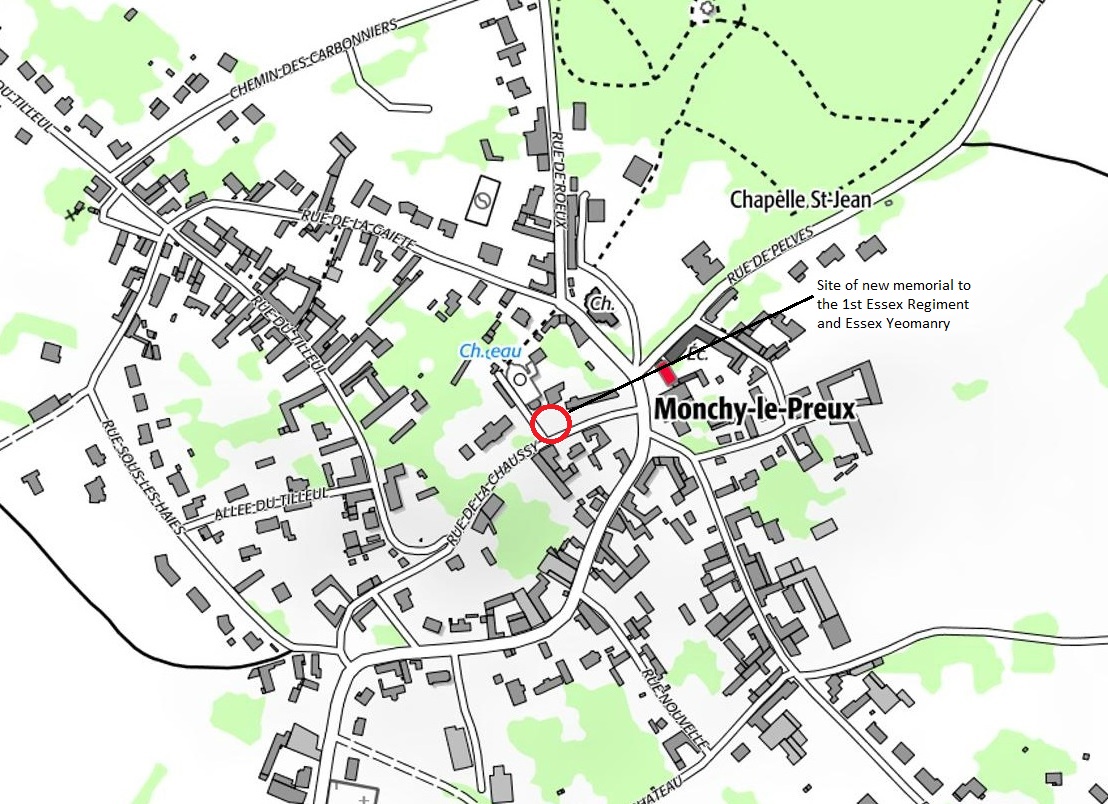
Map showing location of the new memorial to the 1st Essex Regiment and Essex Yeomanry at Monchy-le-Preux. Map courtesy of Geoportail www.geoportail.gouv.fr/
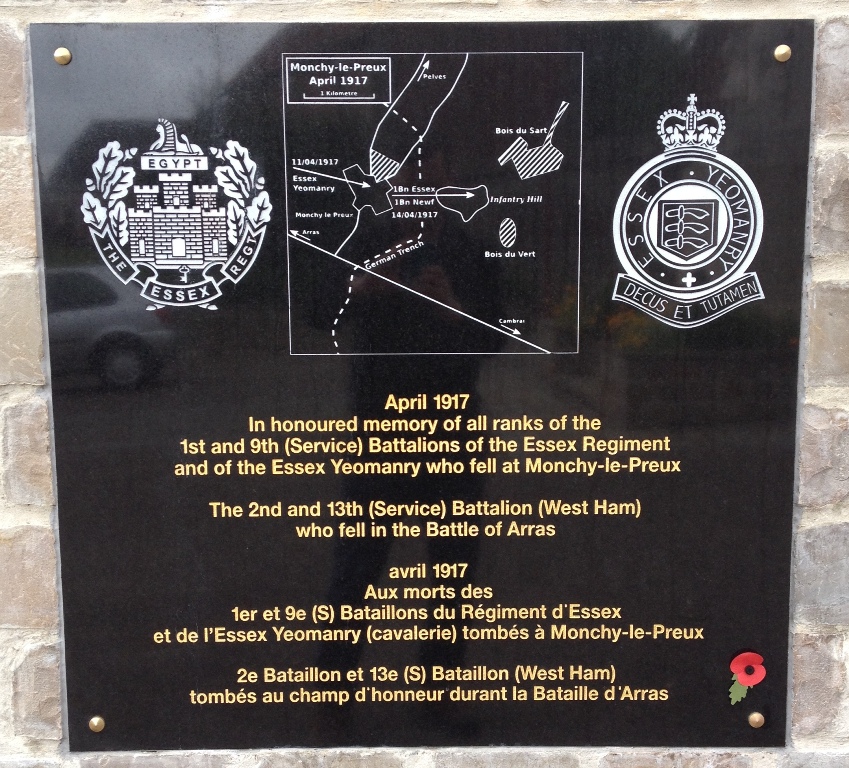
Detail on the plaque, Monchy le Preux
Through my work for Historic England I have come to know many stories of Bristol’s soldiers in the war. A few years ago I met Clive Burlton, a local historian and writer with a superb knowledge of Bristol’s role in the war. Clive and I have given talks at the same venue on a number of occasions and over a post-talk beer often discussed the possibility of running a coach tour to the battlefields for people who want to find out more about Bristol’s wartime story.
So, here we are! I am pleased to announce that, with our partners at Bakers Dolphin, we are running a special tour:
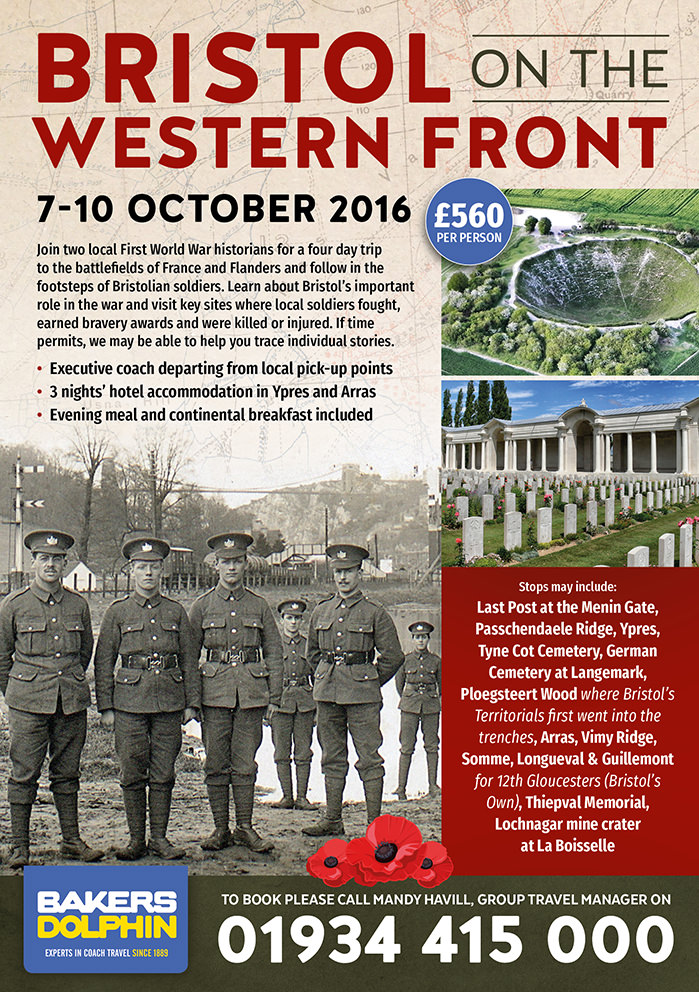
The three night, four day tour will visit key sites where soldiers from Bristol fought, earned bravery awards and lost their lives.
Travelling by executive coach we will depart from Bristol on 7 October and travel to the sacred Ypres salient, the wartime cauldron for so many of Britain’s soldiers. That evening we will attend the Last Post ceremony at the Menin Gate that night. The next day sees us visiting sites around the salient including Ploegsteert (known as Plugstreet to the Tommies) to see where Bristol’s Territorials first went into the trenches before heading south to Arras, our base for the remainder of the trip.
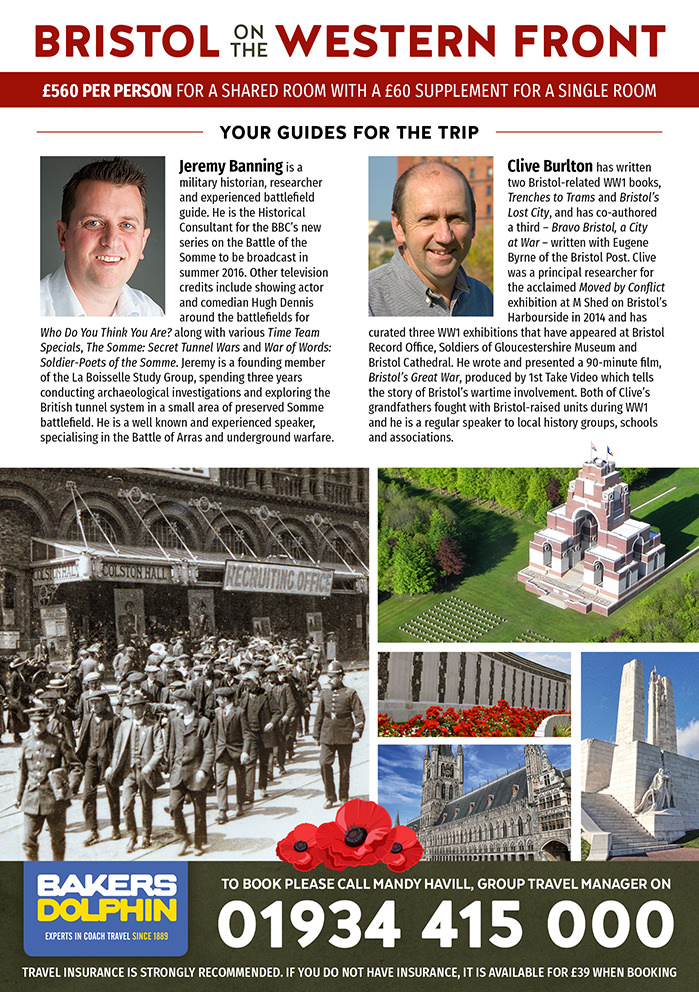
On Saturday 9th we will spend a day on the Somme battlefields, visiting key sites such as Newfoundland Memorial Park, Thiepval Memorial and the Lochnagar Mine Crater. We will also look at the story of the 12th Gloucesters (Bristol’s Own) in their actions at Longueval and Guillemont. The morning of our final day will be spent on the Arras battlefield, looking at the events surrounding the 12th Gloucesters (Bristol’s Own) action at Fresnoy on 8-9 May 1917.
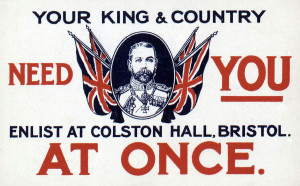
Wartime recruiting card for local soldiers to enlist at Colston Hall, Bristol
Accommodation is based at the following 3-star hotels – Novotel (Ypres) and Holiday Inn Express (Arras). Evening meal and continental breakfast are included. If there is demand then I will give a talk on the tunnellers’ war after dinner one night and Clive on a particular Bristol story the next night.
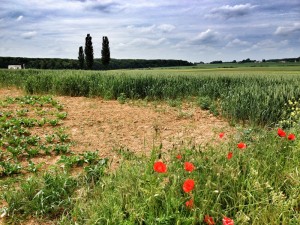
Guillemont – 12th Gloucesters (Bristol’s Own) attacked close to here on 3 September 1916
Individual visits can be accommodated if time permits and locations are close by.
The cost is a competitive £560pp, based on a shared room. For more details please contact me HERE or Mandy Havill, Group Travel Manager on 01934 415 000. I look forward to meeting you on the tour and sharing in Bristol’s fascinating history.
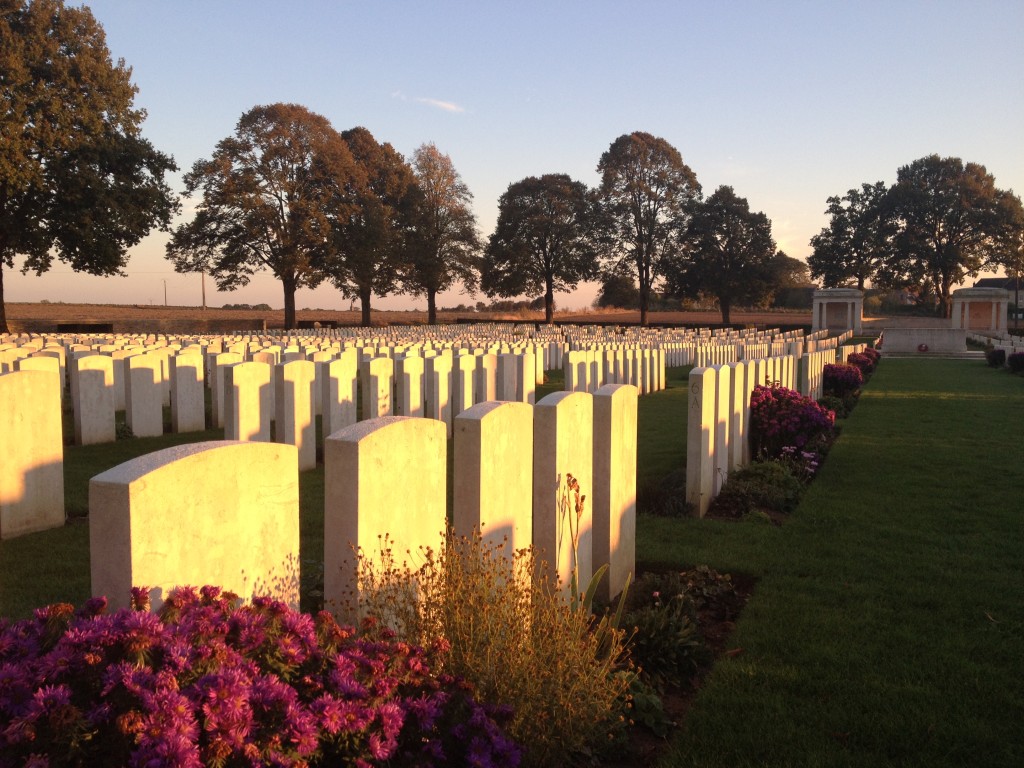
Delville Wood Cemetery, Somme
Last weekend I had the pleasure of guiding nine gentlemen around the Somme and Arras battlefield on bikes. As a keen cyclist I try and take my bike when visiting the battlefields but this was something different in that it was the first organised specialist cycling trip I had put together.
Our base was the delightfully comfortable Les clés des places in the heart of Arras. The Somme was our destination on Friday, leaving the neglected battlefields of Arras for the Saturday.
Day One – The Somme
Friday morning dawned with beautiful weather. With the bikes fixed to the cars we headed south, crossing the ground voluntarily given up by the Germans as they pulled back to the Hindenburg Line in 1917. Parking at Serre Road Cemetery No.2, we got the bikes ready and headed off.
I had sent our proposed route to the group beforehand so everyone was aware of the distances involved. After an introduction of the battle and practices of the CWGC at Serre Road No. 2 we headed across Redan Ridge with its isolated ribbon of battlefield cemeteries to the small village of Beaumont Hamel. As one of the Somme’s most well visited sites with a highly evocative story the Sunken Lane offered our first chance to get to grips with the actions of July and November 1916. After hearing a 1st Lancashire Fusiliers officer, Lt E.W. Sheppard’s description of the 1 July attack we rode via Auchonvillers to Newfoundland Memorial Park where we had a good walk around the trench system, visiting all three cemeteries. The descent to Hamel was fun; infinitely more so than the climb up the Mill Road to the Ulster Tower! One of the group had previously served in the Duke of Wellington’s Regiment so I was able to show him the Pope’s Nose and discuss the 1/5th Battalion’s attempt to capture the position in September 1916.
After a visit to Lutyen’s imposing Thiepval Memorial and our first (and only) puncture of the day we headed via Mash Valley for lunch at the Old Blighty Tea Room in La Boisselle. Subsequent stops included the Lochnagar mine crater, Becourt, Fricourt and Mametz.
From the bottom of Dantzig Alley Cemetery we surveyed the undulating ground in front of us, a familiar view to the British in July 1916. Dominating the landscape is Mametz Wood, scene of so much heartache and horror for the 17th (Northern) and 38th (Welsh) Divisions. Our tour continued up to Montauban and Trônes Wood before a stop at Guillemont Road Cemetery where we paid our respects at the grave of Raymond Asquith, 3rd Grenadier Guards.
Raymond, the son of the Prime Minister H. H. Asquith has been described as ‘one of the most intellectually distinguished young men of his day’. He had been mortally wounded at the start of the Guards’ attack on 15 September 1916 and died on his way to a dressing station.
One of our group was a former Coldstream Guards officer and so we deviated from the original plan, heading to the Guards Memorial between Ginchy and Lesboeufs. The exposed position on the ridge to Lesboeufs is in the centre of the ground over which the Division fought in the second half of September 1916.
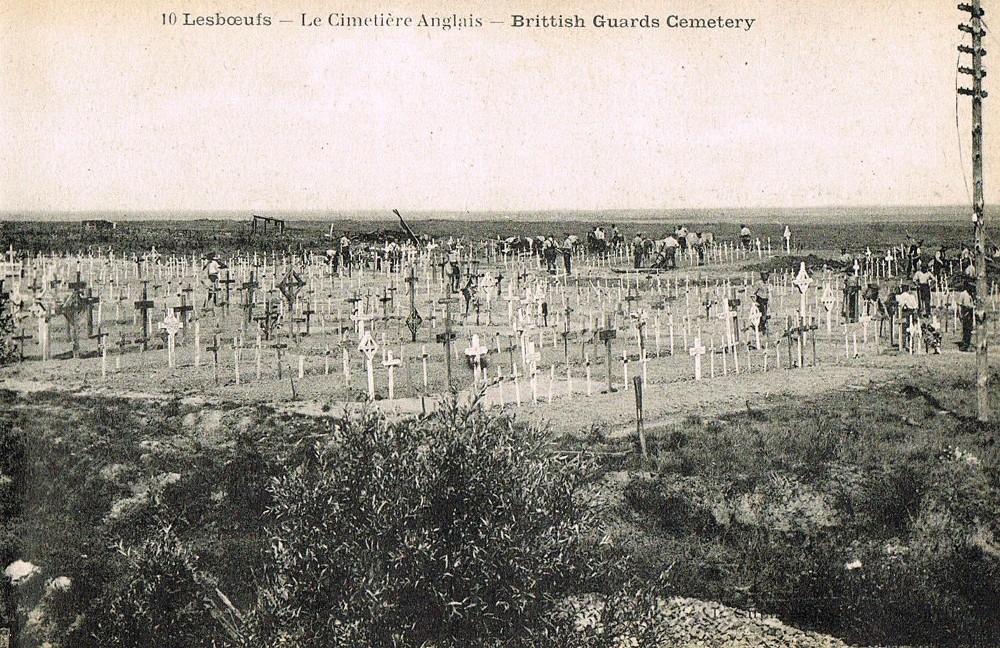
Postwar image of Guards Cemetery, Lesboeufs. The contrast between the haphazard crosses in this postcard and the neat rows of Portland headstones that greet the modern visitor is testament to the skill and dedication of the CWGC.
Our route back across the battlefield took in Delville Wood, looking a perfect picture of peace in dappled sunlight – the polar opposite of summer 1916.
Next up was High Wood where I described the ferocious fighting that had raged there through the high summer of 1916. The wood and Switch Line proved such a bulwark to advance that British efforts resorted to siege warfare techniques; employing Vincent and Livens Large Gallery Flame Projectors in the wood along with the use of tunnellers to plant a mine under German positions. In the late afternoon light of a perfect spring day it was hard to imagine the carnage in these quiet mellow fields and woods.
Crossing the Roman road we headed via Courcelette to Miraumont, along the Ancre valley to Beaucourt before a gentle climb up past Ten Tree Alley en route back to the cars. The conversations that night over a much-needed dinner and drinks all touched on the benefits of cycling in helping everyone’s appreciation of the battlefield.
View this route on plotaroute.com
Day Two – Arras
We awoke the next morning with slightly aching legs and for some, aching heads. There was no need for cars as we would be setting out directly from our hotel. Whilst the touristy spots of the Somme were packed with coaches and school groups the empty fields around Arras are a very different proposition. I assured our travellers that other than farmers and locals we would have the Arras battlefield to ourselves. Heading south via Beaurains (a bike path runs alongside the road for much of this) and London Cemetery we rode to Neuville-Vitasse, a village which in April 1917 was wired into the German defences with the main Hindenburg Line running just behind it.
Heading up the bumpy track to Neuville-Vitasse Road Cemetery was fun. From its dominating position I spoke of the 30th Division’s attack on 9 April 1917, the start of the Arras battle. The closely packed graves of the cemetery are predominantly made up of men from the 2nd Wiltshires and 18th King’s (Liverpool Regiment) who suffered grievous losses attacking across this ground.
I explained the connection with Hugh Dennis’s grandfather, Godfrey Hinnels, whom I had researched for the television programme, ‘Who Do You Think You Are?’ Godfrey’s unit, the 1/4th Suffolk Regiment were tasked with salvage and burial duties in the days after the main attack. As such, it was likely he had been involved with the burial of the men that now lay in the cemetery’s walls.
Next up was Cojeul British Cemetery which is the resting place, amongst others, for two Victoria Cross recipients – Horace Waller, 10th KOYLI and Arthur Henderson, 2nd Argyll & Sutherland Highlanders.
Climbing Henin Hill we visited the remaining German pillbox (MEBU) before our next stop, the isolated and beautiful Cuckoo Passage Cemetery. This small battlefield cemetery, full of Manchester Regiment killed on 23 April 1917 lies at the limit of the Manchesters’ advance. I read aloud an account by Private Paddy Kennedy who served with the 18th Battalion describing events that buy mexican xanax day. Many of his comrades lay around us within the cemetery walls.
We returned back towards Heninel before picking the road up to Chérisy where I discussed the terrible events of 3 May 1917, the Third Battle of the Scarpe. Described by Cyril Falls in the Official History as ‘a melancholy episode’ the attack that day was an unmitigated disaster for the attacking British forces. British dead for the day reached nearly 6,000 for very little material gain.
Why cycling the battlefields is best…
Travelling by bike is by far the best way to appreciate the landscape; you feel every rise, every dip, every change in gradient. What would be a simple drive in a car takes on more meaning when on two wheels. Your thoughts turn irrevocably to the men whose footsteps still echo through the ground as, stealing a line from Sassoon, ‘they slogged up to Arras with rifle and pack’.
Continuing towards Hendecourt our focus changed for a short time as I described the Canadian successes of August and September 1918. Stopping at Sun Valley Cemetery I pointed out the formidable obstacles of Upton Wood and The Crow’s Nest (the latter captured with great daring by the 15th Battalion (48th Highlanders of Canada) on the morning of 1 September 1918). Passing Quebec Cemetery we dropped down for our picnic lunch at the idyllic Valley Cemetery between Vis-en-Artois and Chérisy. This spot is the final resting place of a number of highly decorated officers and NCOs of the 3rd Battalion, Canadian Infantry who were killed nearby at the end of August 1918. Amongst the 3rd Battalion men buried here is the 23 year old Lieutenant Edward Slattery, DCM, MM & 2 Bars. From the decorations received whilst serving in the ranks and his tender age he appears to have been quite some soldier.
Suitably refreshed we headed back towards Guémappe and across the Route National towards Monchy-le-Preux. The road was blocked in the village, the result of a recent building collapse. Undeterred, we headed west where I explained about the village’s capture and the terrible loss of British cavalry in its narrow streets on 11 April 1917.
Having visited the impressive 37th English Division memorial and the Newfoundland Caribou in the village we rode eastwards, up Infantry Hill where I was able to regale the party with the story of the ‘Men who saved Monchy’: the disastrous 14 April 1917 assault by the Newfoundlanders and 1st Essex Regiment.
Infantry Hill is a special spot for me, the scene of so much concentrated fighting and yet, like so much of the Arras battlefield, it remains rarely visited. It was in these fields on 3 May 1917, that disastrous date for the British Army, that one of our group’s great uncles, Private Thomas Clark, 8th East Yorkshire Regiment was killed. Standing close to the spot where the 8th East Yorkshires went over the top I was able to explain the actions that day, reading from the war diary to enable everyone to appreciate the disaster that befell the attacking British troops and the magnificent defensive performance of the German forces.
Extract from the 8th East Yorkshire Regiment after-action report for 3 May 1917 action on Infantry Hill, east of Monchy-le-Preux
The Battalion moved forward at Zero hour [3.45am] but owing to the heavy smoke combined with the darkness they found it difficult to move on any definite point or points.
A platoon commander of the right-hand leading company found himself advancing up a small ridge which is to the south of the copse in O8 Central where he ran up against machine-gun fire. He was joined by a KSLI officer and some men. They moved forward together, the KSLI officer was killed as well as a number of men and as the place was bristling with machine guns and the copse occupied by snipers he stayed down in shell holes, returning at night to HILL TRENCH with 11 men on receipt of orders to do so from Battalion HQ…
…The men were in good heart and moved forward readily. I attribute the results to the heavy smoke, combined with the darkness which prevented people locating their points of direction. In addition to this the enemy barrage was very heavy to which must be added the very effective use of machine-gun both from the front but also enfilading attacking troops.
Casualties: 35 killed, 161 wounded, 39 missing
After some time to contemplate we returned to the village before riding down the Scarpe Valley to Fampoux where we looked at its capture on 9 April 1917 by the 2nd Duke of Wellington’s Regiment. Next up was another special spot; the Seaforth Highlanders cross overlooking the Hyderabad Redoubt, Greenland Hill and Roeux. Whilst there I explained the disastrous 11 April 1917 attack and read aloud the wonderful description left by Seaforth Highlander Private James Stout of events that day.
It is a great shame there is nothing at the former site of the Chemical Works, so bitterly fought over during the battle to show the ferocity of fighting and losses sustained to secure its possession. The site is now a Carrefour mini supermarket where we bought a cool drink and snacks before our ride via Athies back into Arras.
Our final stop of the day was the Arras Memorial where Private Thomas Clark and a further 34,765 men are commemorated. One of the group found the grave of his great uncle in the adjoining Faubourg D’amiens Cemetery. Tired but satisfied at the ground we had covered we headed back to the hotel before a good evening meal and much chat.
View this route on plotaroute.com
Day Three – A quick look north of Arras and back to Blighty
Our final day was overcast and rainy. Bikes were attached to cars before we visited the huge German cemetery at Neuville St-Vaast and French cemetery at La Targette. Next up was the preserved battlefield on Vimy Ridge before our final stop at Walter Allward’s masterpiece, the Vimy Memorial atop Hill 145.
My thanks to the wonderful group who I accompanied and for their generosity and looking after me so well.
If you are interested in a battlefield tour by bike, either as a group or by yourself then please get in touch via the Contact Page. I would be happy to put an itinerary together for any British battlefield and am happy to cycle up to 50 miles/day. However, there is so much to see that 25-40 miles/day is the ideal distance.
I recently led a one day trip to the Arras battlefields for three generations of a soldier’s family (nephew, great-nephew and great-great nephew). I had been asked to research the actions of Private Horace Pantling, 10th Battalion Loyal North Lancashire Regiment around Arras. Horace’s Battalion formed part of 112th Brigade, 37th Division and will be forever known with the actions on 11 April around the small hilltop village of Monchy-le-Preux.
After a general briefing on the battle and a visit to the Carrière Wellington to take a tour around the underground system we headed out on the battlefield, starting on the British front line on 9 April 1917, the first day of battle. Following the arrow straight Arras-Cambrai road I explained the attack British assault up to the Brown Line near Feuchy Chapel. From then I was able to use a series of maps from the 37th Division files that showed positions of units every three hours for the first three days of battle. We followed the 10th Loyal North Lancs in their advance up the road in the early morning of 11 April. With the neighbouring 111th Brigade attacking the village of Monchy it was down to the 112th Brigade to take the Green Line to their right.
The Battalion war diary records that on moving to their assembly positions for the 5.30am advance the 10th Loyal North Lancs immediately were ‘met with very heavy Machine Gun and Shell fire’. However, their assault on the trenches around the La Bergère crossroads was successful and positions were consolidated. Casualties were estimated at 13 Officers and 286 men for the Battalion’s part in the opening stages of the Arras offensive. A number of the Battalion’s dead now lie in the nearby Tank Cemetery.
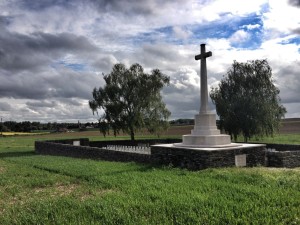
Tank Cemetery, Guemappe where many men of the 10th Loyal North Lancs killed on 11 April 1917 now lie
As we looked over the gently rising fields near Monchy it was hard to imagine the scene in the early morning of 11 April 1917. We had been blessed with a clear, spring day. The British troops who performed so magnificently that day 96 years ago did so with heavy snow and a chill wind across the battlefield.
Having been taken out of the line for a rest they were next in action on 23 April during the 37th Division’s assault on Greenland Hill during the Second Battle of the Scarpe. The war diary made grim reading with very little gain possible owing to the German occupation of the Chemical Works at Roeux on the right. On the 27th orders were received to attack Greenland Hill at dawn the next day. At 4.27am on 28 April that Battalion attacked and reached a trench that had been begun by the enemy. The war diary records that ‘By this time the Battalion had suffered heavily and only one officer was left’. Once more suffering from enfilade fire from the Chemical Works, the Battalion dug in. The attack was yet another failure in the face of superb German resistance.

28 April 1917 map of Greenland Hill overlaid on to Google Earth. Map taken from 37th Division War Diary, National Archives Ref: WO95/2513
It was during the actions on the 28th that Horace Pantling was killed. Horace, like so many British killed in the latter stages of the Arras offensive, has no known grave and is commemorated on the Arras Memorial. We were able to stand close to the positions where the 10th Loyal North Lancs assaulted and then, after a circuitous journey walk close to the spot where the Battalion dug in. It is one of those strange twists of fate that the junction of the A1 and A26 motorways now stands slap-bang right on Greenland Hill. Only by heading toward Plouvain and turning down a narrow track could we get close to the spot where the Battalion ended up. Sadly, the exact spot is now accessible only by driving on the slip road from the A1 to join the A26.
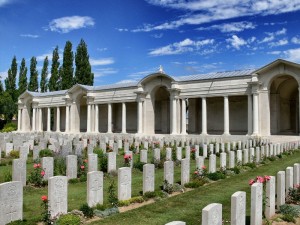
Arras Memorial where Horace Pantling and a further 35,000 servicemen from the United Kingdom, South Africa and New Zealand who died in the Arras sector between the spring of 1916 and 7 August 1918 are commemorated
We had visited Horace’s name on the Arras Memorial earlier in the day so it seemed a suitable place to end the tour. What struck me, as ever, was the small distances – easily covered in a minute or two in the car – that took so much effort to capture and consolidate in spring 1917. The British casualty figures for the Battle of Arras make sobering reading; 159,000 casualties in 39 days – averaging 4000 casualties per day. Despite countless visits to the battlefields such scale of loss in concentrated areas still both appals and moves me. Horace Pantling was one of those casualties but his name is certainly not forgotten and three generations of his family now know the ground over which he fought and was ultimately killed in April 1917.
“Thank you so much for organising such an excellent day in and around Arras last week. We all hugely enjoyed having your professionalism, enthusiasm and knowledge on tap, and your organisation was faultless! My father came away thrilled with the trip, and that was all I could have asked.” Nigel Pantling
A superb resource for those interested in the 10th Loyal North Lancs is Paul McCormick’s website http://www.loyalregiment.com/.
The internet is a wonderful thing; for anyone interested in a certain battalion or unit it is now possible to hammer a few key words into a search engine and find all sorts of information about their part in major, set-piece battles. Forums and discussion groups also have their place. Some regimental museums have even transcribed all of their battalion war diaries, making them available online for free.
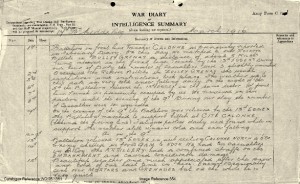
Extract from the 17th Middlesex Regiment War Diary. Reproduced with permission of National Archives, Ref: WO95/1361
Libraries, regimental archives and the National Archives all have information available to help understand events. However, what of the vast majority of time spent not going ‘over the top’ or taking part in the next ‘Big Push’? What of the less-well chronicled, monotonous but necessary routine of trench warfare?
It can be an immensely satisfying task to follow a unit’s movements around the battlefield; this is often undertaken as part of a family pilgrimage or greater desire to ‘follow in the footsteps’ of a relative who served. For me, when battlefield guiding, it is the part of the job that I love the most. Don’t get me wrong – I enjoy a general tour around the main tourist sites as well as the next person but it is in analysing the minutiae of war diary entries and working out such mundane things as billeting arrangements or where sports events were held that yields most fulfilment.
I recently returned from a bespoke trip following the 17th Middlesex Regiment (Footballers’ Battalion) around various villages and towns in French Flanders and the Gohelle coalfields in which they spent November 1915 – March 1916. My client’s grandfather had enlisted underage and spent four months with the battalion before being wounded in mid-March 1916; a wound which saved him from taking part in the Battalion’s action at Deville Wood on the Somme. During the four month period the Battalion held trenches at Cambrin, Givenchy-lès-la-Bassée and Festubert before taking over the Calonne sector from the French at the end of February.
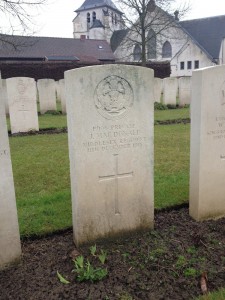
Private James MacDonald, 17th Middlesex – first casualty of the battalion at Cambrin Churchyard Extension
Over the course of our three day trip we visited all of these places, as well as many not associated with the 17th Middlesex; Fromelles, Aubers, Hulluch and Loos. Our stops were not solely restricted to places but included visits to 17th Middlesex Regiment men who had been killed in action. To stand at the grave of Donald Stewart (who served under the alias of Private James MacDonald) in Cambrin Churchyard Extension and know he was the first man of the battalion to be killed in action struck a particular chord. However, for me the highlight came during our visit to Béthune. The Battalion war diary for 2 December records a move to Béthune and billeting in the College des Jeune Filles. I had an old postcard of the college and knew the greater part of it still stood so arranged to visit it during our lunch stop.
Battlefield guides will recognise the satisfying feeling – being able to tell someone that their relative was at that spot on a certain date, not nearby or somewhere in the town but here, actually here. We had the same feeling eating our lunch of ham and cheese baguettes in the square at nearby want to buy ambien online Beuvry. A poorly-attended market filled half of the square but, as we sat eating, I was able to explain that this village, now almost a suburb of Bethune was where the Footballers’ Battalion had spent Christmas Day 1915. There was no plaque commemorating this event, no visible link at all, just the knowledge that men of the Battalion would have walked around the square over the festive time, amongst them my client’s grandfather. It made the lunch, eaten in the car whilst a steady drizzle fell that bit more special.
After a tour around the Loos battlefield I took my client to the site of Middlesex and Football Trench in the Calonne North sub-sector. It was here in that his grandfather was wounded in March 1916. The war diary of the 16th records ‘4 casualties occurred from GRENADES, 2 in “B” Coy and 2 in “D” Coy’; it is likely that my client’s grandfather was one of those wounded men as he left France on the 18th, crossing the channel for treatment at a hospital in Britain. Such were the effect of the wounds received that he was discharged from service three months later. Compared to many who served, his war was unremarkable – his service record shows he played no part in any major offensive and yet the four months he spent with the 17th Middlesex from November 1915 – March 1916 had a profound effect on him for the rest of his life.
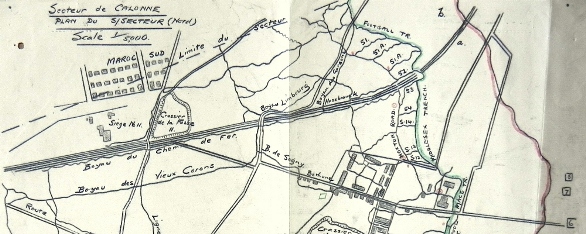
Map of Calonne North Sector showing Football and Middlesex Trenches . Reproduced from 6th Infantry Brigade War Diary held at National Archives, Ref: WO95/1353
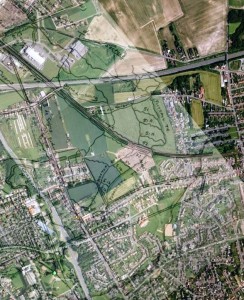
Calonne North map overlaid on to Google Earth. Football Trench runs between the A21 motorway and the Lens – Bethune railway embankment.
Football Trench ran through what is now an open field next to the A21 motorway and the urban sprawl of miners’ cottages of Liévin. The railway line from Lens to Bethune runs across the northern tip of Middlesex Trench. Much of the rest of it is hidden under a civilian cemetery or is being built upon for new housing. A casual visitor to the site today would find it far from enchanting. Locals stared at our car with British number plates; clearly, the back streets of Liévin didn’t see too many battlefield tourists. However, the relative inaccessibility of the spot made visiting it that bit more special. To those of us in the car, it felt as though we had tracked down a site rather than merely followed the tourist signs. Having researched the young Middlesex soldier it certainly had an effect on me. It was a real pleasure to be able to share these places with his grandson; not just the obvious sites of front line and communication trenches but the places in he was billeted, the towns and villages he would have known well and the roads he marched along on his route to and from the front. To me, this is what makes following in a soldiers footsteps such an enriching experience.
N.B. A very readable account of the 17th Middlesex Regiment is Andrew Riddoch & John Kemp’s ‘When the Whistle Blows: The Story of the Footballers’ Battalion in the Great War’ – highly recommended.
Following in the footsteps of the 9th Battalion Rifle Brigade at the Battle of Arras (April – May 1917)
Earlier this month having spent a few days recceing sites and walks for upcoming trips I spent a day showing a client, Tony Wright, around the Arras battlefields following in the footsteps of his great uncle, S/30401 Rifleman Herbert William Victor Wright, 9th Battalion Rifle Brigade who was killed on 3 May 1917. It was most likely that Herbert had joined the battalion as one of nearly four hundred reinforcements received in January 1917. As such, the spring offensive at Arras would be his first major battle.
Sadly, Herbert Wright’s service record no longer existed and so we were unable to determine which company he had served in. However, with the knowledge that he would have been ‘in the area’ we started off by looking at the battalion’s role in the 9 April attack. The 9th Battalion Rifle Brigade was part of 42nd Infantry Brigade, 14th (Light) Division. The divisional objectives for 9 April were to capture the strong German position known as the Siegfried Stellung, (Hindenburg Line) which the Germans had fallen back to throughout the month of March. The hinge of the ‘old’ German line and new Hindenburg Line was the village of Tilloy-lès-Mofflaines. South of the village lay the 14th Division’s objective, the southern part of The Harp, a formidable position some 1000 yards long and 500 yards wide, full of tangled field defences. Along with Telegraph Hill to its immediate south its dominant position enabled German defenders to fire in enfilade northwards up Observation Ridge and southwards to Neuville Vitasse; its capture was absolutely critical.

Looking across the rising ground of The Harp. The 9th Rifle Brigade advanced across here on 9 April 1917
The role of the 9th Rifle Brigade on 9 April was limited to that of ‘moppers-up’. An initial assault was to be made against the southern portion of ‘The String’, a trench running down the length of The Harp, by the 5th Ox and Bucks Light Infantry and 9th King’s Royal Rifle Corps. Once captured the 5th King’s Shropshire Light Infantry would then pass through or ‘leapfrog’ the two battalions to capture the second objective close to the Blue Line running south from the rearward face of The Harp down the Hindenburg Line. Nearly seven hours after the initial advance and with these objectives taken B & D Companies of the 9th Rifle Brigade, under the command of Captain Buckley were to leave their positions in and around the old German front line to clear the ground between the Blue and Green lines within the Brigade boundaries.
They would also occupy an outpost line north east of the Tilloy – Wancourt road (now the D37). Considering the magnitude of the day’s fighting the Battalion war diary gives scant information about the work completed other than to record the final objective was gained by 1.30pm with one hundred prisoners and two machine guns captured. Casualties sustained were Captain D.E. Bradby killed , 2/Lt H.M. Smith wounded and fifteen Other Ranks wounded. Despite differing figures from those provided in Brigade records it is clear that losses amongst the 9th Rifle Brigade were extremely light when compared to other battalions within 42nd Brigade.
After relief on 12 April the Battalion spent time in training where they received a draft of fifty two reinforcements. On 23 April the Battalion began their march back to the battlefield, moving into newly captured positions between Guémappe and Chérisy on the evening of the 24th. The war diary records constant shellfire for this entire period; on one day alone 2/Lt J.M. Harper and a further sixteen Other Ranks were wounded. Between 30 April – 2 May the Battalion were in reserve but provided working parties to dig out a new communication trench named Jungle Alley running between the Ape and the Boar trenches before taking up their positions in the front line north of Chérisy on 2 May. The stage was set for a renewal of the offensive; three armies would be attacking along a fourteen mile frontage from Bullecourt in the south to Fresnoy in the north. Having suffered such comparatively small losses on 9 April the 9th Rifle Brigade was to take a leading part in the coming battle, attacking on the left of the Brigade next to the 5th Ox & Bucks Light Infantry. The 5th King’s Shropshire Light Infantry and 9th King’s Royal Rifle Corps were in Brigade Reserve.
The decision to launch the attack at 3.45am in darkness was contentious. Many commanders protested to no avail. A further complication for the 9th Rifle Brigade was their position nearer to the enemy than neighbouring units. As such, they were not to advance from their jumping off line until eighteen minutes after Zero Hour. The Battalion had two objectives; firstly to capture the Blue Line running in front of Triangle Wood and through Hill Side Work and then to push on to the Red Line, completing the capture of both positions. Advancing from a line 150-200 yards east of the front line marked by white tape fixed to the ground, the Battalion was to advance behind a ‘creeping barrage’ of artillery shells exploding in a slowly moving curtain across the battlefield.
Ten minutes before Zero Hour the first wave left the assembly trenches to line up on the tape. At 4.03pm they advanced, followed by the second wave that left the assembly trenches at Zero +42 minutes. In common with many units who attacked that dreadful day, no further report was ever received from the companies in the first wave. German artillery fire was extraordinarily heavy (lasting for over fifteen hours) with eight company runners either killed or wounded. Post -action reports noted the first wave veered to the right in the darkness, striking a new German trench wired and held by the enemy. Despite this, it was captured by Zero + 40 minutes and advance progressed. However, enfilade machine gun fire caused heavy casualties and ‘few, if any ever reached the rear of Hill Side Work’. All eight officers of the first wave became casualties very early in the day, some being wounded several times. Only seven NCOs of the first wave ever returned. The second wave fared no better. As their advance was in daylight they were subjected to machine gun fire sooner than the first wave and also came up against machine gun positions which had been established after or missed in the dark by the first wave, in addition to enfilade fire from across the Cojeul valley near St Rohart’s Factory.
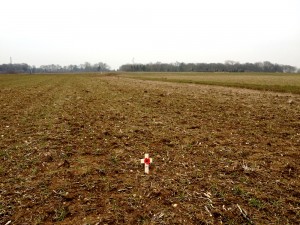
Cross left in memory of Herbert Wright, 9th Rifle Brigade. Triangle Wood and Hill Side Work are on the horizon
The second wave was finally held up just in front of Spotted Dog Trench which was held by the enemy; they dug in along a line of shell holes about 600 to 700 yards in front of their original front line at Ape Trench. A German counter-attack against the 18th Division who had captured Chérisy forced their line back to its starting position; this action rippled northward with orders sent out to recall the Battalion. Such was the dominance of German artillery and machine gun fire (firing continuously from both flanks and from across the river valley) that these orders could only be communicated to two platoons; it being impossible to contact the remnants of the battalion occupying shell holes close to Spotted Dog Trench. On the evening of the 3rd two patrols were sent to recall one company holding a line of shell holes and strong point close to the German trench. Over the next couple of nights survivors of the 9th Rifle Brigade’s attack returned to the original British line. The Battalion’s casualties during the day’s operations were 12 officers and 257 Other Ranks. The 9th Rifle Brigade was relieved on 4 May before heading back to The Harp. This disastrous day marked the beginning of the end of the Battle of Arras. Desperate fighting continued for possession of Roeux, its infamous Chemical Works and Greenland Hill plus around Fresnoy which was recaptured on 8 May. However, by then British attentions were turning northwards to Flanders.
As Herbert Wright’s company is unknown it proved impossible to know whether he formed part of the first or second wave of attackers. Tony and I we walked the attack, passing the assembly trench positions, taped line from which the battalion advanced before moving to the final positions reached. It was here that Tony laid a small poppy cross in memory of his great uncle. Herbert Wright was one of ninety seven men of the Battalion killed on 3 May; all but two are commemorated on the Arras Memorial to the Missing. We visited the Arras Memorial and saw Herbert Wright’s name on Panel 9.
His remains may be buried in the grave of an unknown soldier or still be out on the battlefield. The Third Battle of the Scarpe, as the fighting over 3/4 May was named, was an unmitigated disaster for the British Army which suffered nearly 6,000 men killed for little material gain.
In the Official History, Military Operations France and Belgium 1917 Cyril Falls gives the following reasons for the failure on 3 May 1917 in the VII Corps frontage:
“The confusion caused by the darkness; the speed with which the German artillery opened fire; the manner in which it concentrated upon the British infantry, almost neglecting the artillery; the intensity of its fire, the heaviest that many an experienced soldier had ever witnessed, seemingly unchecked by British counter-battery fire and lasting almost without slackening for fifteen hours; the readiness with which the German infantry yielded to the first assault and the energy of its counter-attack; and, it must be added, the bewilderment of the British infantry on finding itself in the open and its inability to withstand any resolute counter-attack.”
This stark paragraph illustrates perfectly the battlefield during the 3 May 1917 fighting; nightmarish, terrifying and bloody. Having been at home for a week now I am still thinking about it and the windswept ridge between Guémappe and Vis-en-Artois.
“I spent an extraordinary day with Jeremy walking in the footsteps of my Great Uncle, who fell on May 3rd 1917 at the Battle of Arras. He did a wonderful job of balancing a very good explanation of the complexities of the overall battle itself with a highly emotional and personal end to the day of literally experiencing his final hours. As my Great Uncle was a private soldier, without detailed records of his service easily available, I was deeply impressed by how he brought together a range of different sources to nevertheless give me a really specific and personal understanding of what he and his comrades went through. It was an absolutely unforgettable experience”. Tony Wright
A good write up of the part played by one young officer, 2/Lt William Clarke Wheatley, former pupil at Sandbach School who was killed in the 3rd May attack can be found on Conor Reeves’ excellent website: http://sommejr.wordpress.com/william-clark-wheatley-3517/.

